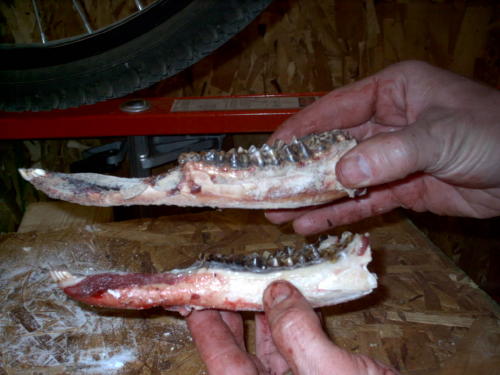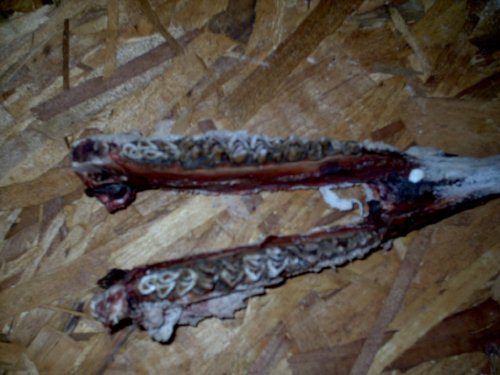|
Aging DeerAging the bucks that we shoot is more difficult; we would like to get a more reliable age. To do this we have started to learn how to age deer by looking at the tooth wear and replacement of the lower jaw teeth. This method is more exact for aging deer that are in the younger age classes, up to 6 years old. We have only attempted to age two deer using this method and have discovered that it is going to take some practice. I wish that we had tried aging deer with this method with all five deer that we shot this year. The first deer that we used the tooth wear and replacement deer aging method on was the buck that Ryan shot. Even though I thought that this was a 3½ year old buck it looked like he was actually 2 ½ from his tooth wear. The next deer that we tried to age was a doe that I shot late in muzzleloader season. From her appearance and lower front tooth wear I would have guessed that she was a young deer. The tooth wear and replacement of the lower jaw teeth told us otherwise. The final consensus was that she was 5 ½. The teeth of this deer also made the whole deer aging method a little fuzzier than I first thought. When I originally extracted her jaw and upon my initial look, I still thought that she was a young deer. This all changed when I compared her jaw to the bucks. There was a marked difference. Obviously she was older than 2 ½. This has led me to realize that it will take some practice before I’m real confident about aging deer by looking at the teeth. When the description below tells you to compare the widths of the dentine and enamel, there is a fine line there. I’ve kept both jaws to compare to the deer that we shoot next year so that we can learn more.
Here is the method of aging deer using the lower jaw tooth wear and replacement method that was published in 1991 by James C. Kroll and included in the book Quality Whitetails. If the lower jaw has fewer than five jaw teeth (three premolars and two fully erupted molars), the deer is les than 1 year of age and should be classified as a fawn. This age class also is easily distinguished by the small size of the jaw. If the deer is not a fawn, examine the third jaw tooth (last premolar). In fawns and yearlings, this tooth is unlike any other, containing three cusps. The soft, deciduous nature of these teeth may cause confusion, since they often are worn smooth by 18 to 20 months. Therefore, even if the first three jaw teeth are well worn, look carefully at the third tooth. If it has three cusps, the deer is a yearling, called so because it is about 18 months of age. Occasionally, late fawning dates or poor nutrition result in some yearlings not having a fully erupted third molar. If, however, the deer has three premolars and two fully erupted molars, it should be classified as a yearling, not a fawn. Deer with six jaw teeth where the third tooth does not have there cusps are normally older than 1 ½ years. The first three teeth generally are replaced with permanent teeth containing the normal two-cusp structure between 18 and 30 months of age. Frequently yearlings are harvested with two cusped molars that have just replaced the three=cusped third premolar. These are distinguished from two year old deer by the lack of stain and wear on the premolars, compared with the molars in the mouth. Additionally, the premolars may not be completely erupted. Since the fourth tooth (first molar) is added before shedding of the premolars, it is the oldest jaw tooth and will remain so throughout the life of the deer. This is the tooth to examine next. The jaw teeth of deer, and all mammals, have two layers as determined by Weichert in 1970, an inner core of brownish dentine covered with a hard white enamel layer. The teeth become increasingly worn as the deer chews. Since the cusps are cone shaped, wear exposes more and more dentine. The relative amount of dentine exposed can be used as an indicator of age in older deer. For example, if the third tooth has only two cusps and is stained, the deer in not a yearling. Examine the oldest tooth, the fourth (first molar), comparing the relative widths of dentine (brown) and enamel (white) of cusps on the lingual (tongue) side of the jaw. If the dentine is not wider than the enamel, wear has not progressed and the animal should be classified as 2 ½ years old. If, however, the fourth tooth shows considerable wear, the deer is older than 2 ½ years. Examine the next oldest tooth, the fifth (second molar). Again, relative widths of dentine and enamel on the lingual side cusps should be compared. If the dentine is not wider than the enamel layer, the animal is 3 ½ years old. If the dentine of the fifth tooth is wider than the enamel on the lingual side cusp, examine the sixth tooth (last molar) using the same criteria. If the lingual side cusps are sharp, with dentine not wider than the enamel, the deer is 4 ½ years of age. If not, the deer is at least 5 ½ years old. Return to the fourth tooth and examine the relative amount of enamel remaining in the center of the tooth. If the tooth has become so worn that little enamel remains in the center of the tooth, the deer is 6 ½ years old. If not, the deer is 5 ½ years of age. It is possible to age a deer beyond 6 ½ years but this is rarely necessary. Many managers combine all deer 6 ½ years or older into a single classification.
There you have it. That is the tooth wear and replacement method of aging a whitetail deer. I don’t know about you, but I had to read it several times before I understood how it all works. I had to stand there and keep looking back and forth between the book and the teeth. I think we finally have a handle on it and will continue to remove the jaws of the deer we shoot to get better at aging them. One caution that I have is that you remove the lower jaw as soon as possible. Once the deer stiffens up it is real difficult to get the mouth open again. Once I did get the jaw open, I used loping shears (tree trimming shears) to cut the jaw bone off. The doe that we aged had a lot of junk on her teeth. I had to brush her teeth so that we could get a good look at them. My wife thinks I’m going crazy. Aging deer was always something that I wanted to do. It is an important part of a management program. I finally took the first step and it will be interesting to see how it goes next fall, we’ll check them all. We have now purchased a Deer Aging Tool to help us determine the age of the deer that we shoot on our property.
|


